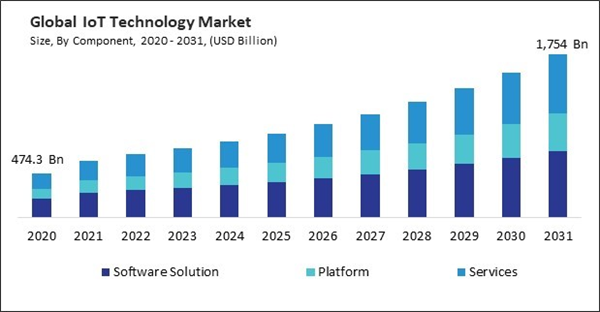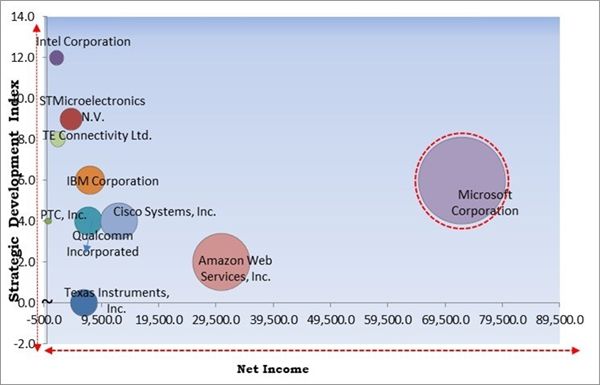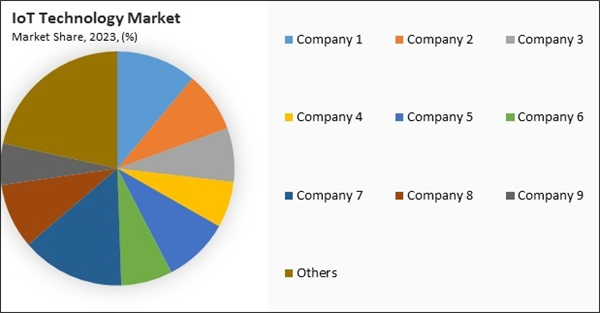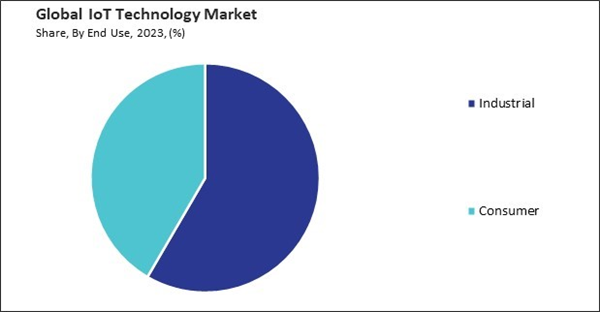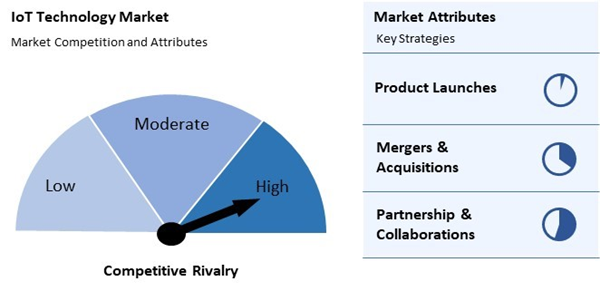The Global IoT Technology Market size is expected to reach$1.75 trillion by 2031, rising at a market growth of 11.4% CAGR during the forecast period.
The use of sensors comes in various types, such as temperature, humidity, motion, pressure, and proximity, each tailored to capture specific data types. Sensors are used for real-time monitoring and surveillance in IoT applications like smart cities and houses, and industrial facilities. Thus, the Sensor segment garnered $1,59,298.2 million revenue in the market in 2023. Sensors are deployed to collect data from various sources, including environmental conditions, equipment performance, human activity, and other parameters relevant to specific IoT applications.
The major strategies followed by the market participants are Partnerships as the key developmental strategy to keep pace with the changing demands of end users. For instance, In May, 2024, Qualcomm Incorporated came into partnership with Aramco, to create advanced end-to-end IoT solutions tailored to the unique needs of the Kingdom of Saudi Arabia, demonstrating cutting-edge and sustainable digital transformation in the industrial sector. Moreover, In February, 2024, IBM Corporation came into partnership with Wipro Limited. Through this partnership, IBM would develop joint solutions that promote the implementation of robust, reliable, integrated, and enterprise-ready AI systems.
As the number of electronic devices, such as smartphones, tablets, wearables, and smart home appliances, continues to increase globally, so does the potential for IoT connectivity. These devices serve as endpoints for IoT solutions, providing the means to collect, transmit, and receive data from the physical world. The increasing prevalence of electronic devices in enterprise environments creates opportunities for IoT solution providers to deliver value-added services, such as predictive maintenance, asset tracking, and supply chain optimization. Thus, the expansion of electronic devices sector worldwide creates a fertile environment for the growth of the IoT technology market.
The leading players in the market are competing with diverse innovative offerings to remain competitive in the market. The above illustration shows the percentage of revenue shared by some of the leading companies in the market. The leading players of the market are adopting various strategies in order to cater demand coming from the different industries. The key developmental strategies in the market are Partnership and Collaboration.
The IoT technology market is fiercely competitive, characterized by rapid innovation and diverse applications across industries. Major players like IBM, Cisco, Microsoft, and Amazon Web Services lead the market, leveraging extensive resources to develop comprehensive IoT solutions. The competition is further intensified by numerous startups and smaller companies that focus on niche markets or cutting-edge technologies. Key competitive factors include scalability, security, interoperability, and ease of deployment. Strategic alliances, acquisitions, and partnerships are prevalent as companies aim to bolster their IoT portfolios and market presence.
The use of sensors comes in various types, such as temperature, humidity, motion, pressure, and proximity, each tailored to capture specific data types. Sensors are used for real-time monitoring and surveillance in IoT applications like smart cities and houses, and industrial facilities. Thus, the Sensor segment garnered $1,59,298.2 million revenue in the market in 2023. Sensors are deployed to collect data from various sources, including environmental conditions, equipment performance, human activity, and other parameters relevant to specific IoT applications.
The major strategies followed by the market participants are Partnerships as the key developmental strategy to keep pace with the changing demands of end users. For instance, In May, 2024, Qualcomm Incorporated came into partnership with Aramco, to create advanced end-to-end IoT solutions tailored to the unique needs of the Kingdom of Saudi Arabia, demonstrating cutting-edge and sustainable digital transformation in the industrial sector. Moreover, In February, 2024, IBM Corporation came into partnership with Wipro Limited. Through this partnership, IBM would develop joint solutions that promote the implementation of robust, reliable, integrated, and enterprise-ready AI systems.
Cardinal Matrix - Market Competition Analysis
Based on the Analysis presented in the Cardinal Matrix, Microsoft Corporation is the forerunner in the IoT Technology Market. In January, 2024, Microsoft Corporation came into partnership with Vodafone Idea Limited. Through this partnership, Microsoft would enhance its strengths in delivering scalable digital platforms to over 300 million businesses, public sector organizations, and consumers throughout Europe and Africa. Companies such as Amazon Web Services, Inc. Cisco Systems, Inc., and Qualcomm Incorporated are some of the key innovators in the IoT Technology Market.Market Growth Factors
As companies and institutions strive to arrive at better informed judgments, there's a growing reliance on data-driven insights. IoT technology facilitates the collection of vast amounts of data from connected devices and sensors, enabling organizations to analyse this data for valuable insights into customer behaviour, operational efficiency, and market trends. Predictive maintenance uses machine learning algorithms to anticipate equipment failures before they occur, minimizing downtime, reducing maintenance costs, and optimizing asset performance. Thus, the rising demand for collecting, processing, and analysing large volumes of data fuels the growth of the IoT technology market.As the number of electronic devices, such as smartphones, tablets, wearables, and smart home appliances, continues to increase globally, so does the potential for IoT connectivity. These devices serve as endpoints for IoT solutions, providing the means to collect, transmit, and receive data from the physical world. The increasing prevalence of electronic devices in enterprise environments creates opportunities for IoT solution providers to deliver value-added services, such as predictive maintenance, asset tracking, and supply chain optimization. Thus, the expansion of electronic devices sector worldwide creates a fertile environment for the growth of the IoT technology market.
Market Restraining Factors
Security breaches and privacy incidents erode consumer trust in IoT devices and services. When consumers perceive IoT technology as insecure or invasive of their privacy, they may hesitate to adopt these solutions or discontinue using them altogether. Moreover, IoT devices collect vast amounts of data about users' behaviour, preferences, and activities. Customers are becoming more cautious about disclosing personal information to Internet of Things devices, with IoT devices, especially considering high-profile data scandals involving tech companies. Thus, concerns regarding security and data privacy hinders the IoT technology market.The leading players in the market are competing with diverse innovative offerings to remain competitive in the market. The above illustration shows the percentage of revenue shared by some of the leading companies in the market. The leading players of the market are adopting various strategies in order to cater demand coming from the different industries. The key developmental strategies in the market are Partnership and Collaboration.
Driving and Restraining Factors
Drivers- Rising Demand for Collecting, Processing, and Analysing Large Volumes of Data
- Expansion of Electronic Devices Sector Worldwide
- Government Support for Small and Medium-Sized Enterprises
- Concerns Regarding Security and Data Privacy
- High Cost of IoT Devices and Services
- Increasing Emergence of Different Applications and Use Cases
- Rising Demand for Automation and Remote Monitoring
- Infrastructure Limitations in Regions with Inadequate Infrastructure
- High Power Consumption and Limited Battery Life
End Use Outlook
On the basis of end use, the market is classified into industrial and consumer. The industrial segment recorded 58% revenue share in the market in 2023. Industrial organizations are prioritizing digital transformation initiatives to modernize legacy systems, improve operational efficiency, and meet evolving market demands. IoT technology is central to digital transformation efforts by enabling connectivity, data integration, and analytics across the entire value chain.Component Outlook
By component, the IoT technology market is segmented into software solution, platform, and services. The services segment procured 35% revenue share in the market in 2023. Services in the market encompass a range of offerings including installation, integration, consulting, and maintenance services. The significant revenue share of this segment reflects the complexity and need for expert support in deploying and managing IoT solutions.Node Component Outlook
On the basis of node component, the market is classified into processor, connectivity IC, sensor, memory device, and logic device. The processor segment recorded 34% revenue share in the market in 2023. As the component that handles data processing and decision-making tasks within IoT devices, processors are fundamental to the performance of IoT systems. The fact that this segment recorded the largest revenue share suggests a high demand for advanced processing capabilities, likely driven by the increasing complexity and sophistication of IoT applications.By Regional Analysis
Region-wise, the market is analysed across North America, Europe, Asia Pacific, and LAMEA. The North America segment garnered 39% revenue share in the market in 2023. North America, especially the United States and Canada, has a well-established technological infrastructure, which supports the deployment and expansion of IoT solutions. This region often leads in technological innovations, including the development and application of IoT technologies in industries such as healthcare, automotive, manufacturing, and smart cities.Market Competition and Attributes
The IoT technology market is fiercely competitive, characterized by rapid innovation and diverse applications across industries. Major players like IBM, Cisco, Microsoft, and Amazon Web Services lead the market, leveraging extensive resources to develop comprehensive IoT solutions. The competition is further intensified by numerous startups and smaller companies that focus on niche markets or cutting-edge technologies. Key competitive factors include scalability, security, interoperability, and ease of deployment. Strategic alliances, acquisitions, and partnerships are prevalent as companies aim to bolster their IoT portfolios and market presence.
Recent Strategies Deployed in the Market
- Qualcomm Incorporated came into partnership with Sasken Technologies, an Indian multinational technology company. Through this partnership, Qualcomm would strengthen our unwavering commitment to excellence and innovation in technology. Additionally, partnering with Qualcomm Technologies offers tremendous potential and opens up exciting opportunities for both companies.
- PTC, Inc. came into partnership with Quasar India Limited, a provider of high-performance time-series database solutions at the edge and in the cloud. Through this partnership, PTC, Inc. would empower a wide range of IoT clients with robust data solutions, enhancing their capabilities and efficiency in leveraging IoT technologies.
- PTC, Inc. came into partnership with Rockwell Automation, an American provider of industrial automation and digital transformation technologies. Through this partnership, PTC, Inc. would advance the integration of Internet of Things (IoT) and augmented reality (AR) technologies in manufacturing. Additionally, this partnership aims to drive innovation and efficiency in manufacturing processes by leveraging cutting-edge IoT and AR software solutions.
- Intel Corporation came into partnership with Cisco Systems, Inc., an American multinational digital communications technology conglomerate corporation. Through this partnership, Intel would develop reference architectures for different sectors of the Internet of Things (IoT) industry, such as manufacturing, supply chain, and smart venues. This initiative aims to broaden and enhance Cisco's Private 5G solution blueprint by leveraging Managed Service Provider (MSP) partners for scalability and expansion.
- Amazon Web Services, Inc. came into partnership with Kore.ai, a US-based Software Development company. Through this partnership, AWS would enhance the deployment, management, and security aspects of its Massive IoT solutions.
List of Key Companies Profiled
- Intel Corporation
- Qualcomm Incorporated (Qualcomm Technologies, Inc.)
- Texas Instruments, Inc.
- STMicroelectronics N.V.
- Cisco Systems, Inc.
- IBM Corporation
- Microsoft Corporation
- Amazon Web Services, Inc. (Amazon.com, Inc.)
- PTC, Inc.
- TE Connectivity Ltd.
Market Report Segmentation
By End Use- Industrial
- Consumer
- Software Solution
- Data Management
- Real-Time Streaming Analytics
- Remote Monitoring
- Network Bandwidth Management
- Security Solution
- Platform
- Device Management
- Application Management
- Network Management
- Services
- Professional Services
- Managed Services
- Processor
- Logic Device
- Memory Device
- Sensor
- Connectivity IC
- North America
- US
- Canada
- Mexico
- Rest of North America
- Europe
- Germany
- UK
- France
- Russia
- Spain
- Italy
- Rest of Europe
- Asia Pacific
- China
- Japan
- India
- South Korea
- Singapore
- Malaysia
- Rest of Asia Pacific
- LAMEA
- Brazil
- Argentina
- UAE
- Saudi Arabia
- South Africa
- Nigeria
- Rest of LAMEA
Table of Contents
Chapter 1. Market Scope & Methodology
Chapter 2. Market at a Glance
Chapter 3. Market Overview
Chapter 4. Competition Analysis - Global
Chapter 5. Global IoT Technology Market by End Use
Chapter 6. Global IoT Technology Market by Component
Chapter 7. Global IoT Technology Market by Node Component
Chapter 8. Global IoT Technology Market by Region
Chapter 9. Company Profiles
Companies Mentioned
- Intel Corporation
- Qualcomm Incorporated (Qualcomm Technologies, Inc.)
- Texas Instruments, Inc.
- STMicroelectronics N.V.
- Cisco Systems, Inc.
- IBM Corporation
- Microsoft Corporation
- Amazon Web Services, Inc. (Amazon.com, Inc.)
- PTC, Inc.
- TE Connectivity Ltd.
Methodology

LOADING...



